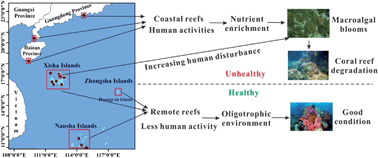Potential impacts of anthropogenic nutrient enrichment on coral reefs in the South China Sea: evidence from nutrient and chlorophyll a levels in seawater†
Abstract
Anthropogenic nutrient enrichment is considered to be one of the causes resulting in coral reef decline. In order to better understand the trophic status and to further explore the potential impacts of nutrients on the coral reef decline in the South China Sea (SCS), we investigated the nutrient and chlorophyll a (chl a) distributions in the surface water of reef areas across latitudes from 9–22° of the SCS. The results showed that nutrient and chl a concentrations in coastal reefs were obviously higher than those in the central and southern basin. Meanwhile, the investigation of two long-distance transects revealed an inshore–offshore nutrient decreasing trend. However, some offshore coral reefs, such as Yongxing Island, Huaguang Reef and Huangyan Island, were exceptions with relatively higher concentrations than in the surrounding reefs because of the ever-increasing human activity. Compared to other coral reefs worldwide, the nutrient concentration in reef regions of the northern and central SCS was obviously higher than that in healthy coral reefs, approaching that in unhealthy reef areas, which suggested that the present nutrient concentration may reach a risky level. Field survey showed a high ratio of macroalgal cover and coral cover in these reefs, and the significant correlation between the nutrient level and macroalgal cover indicated that elevated nutrients resulted in the phase shift from coral-dominated to macroalgal-dominated reef areas. On the other hand, a significant positive correlation between chl a in lagoons and the volume of lagoons indicated that the structural properties of large lagoons could enhance retention of nutrients and promote the growth of macroalgae, and human disturbance may aggravate the macroalgal overgrowth. Overall, anthropogenic nutrient enrichment has caused negative impacts on coral reefs of the SCS, such as regional macroalgal blooms in coastal reefs and disturbed remote reefs.

- This article is part of the themed collection: Geochemistry


 Please wait while we load your content...
Please wait while we load your content...